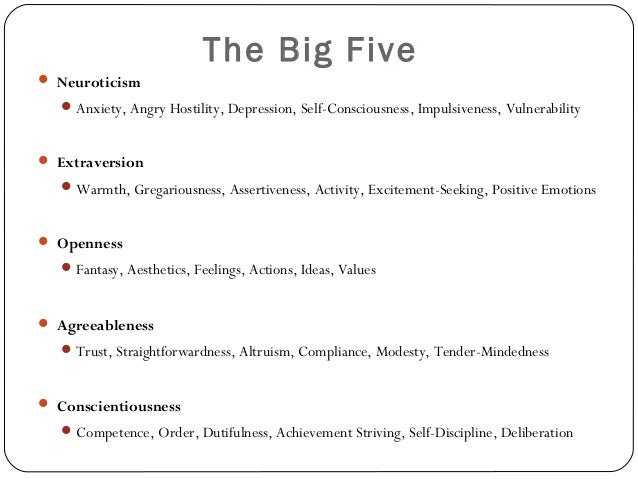What is the NEO-PI-3? The NEO-PI-3 is the updated version of the Revised NEO Personality Inventory (NEO PI-R) – the standard questionnaire of the Five-Factor Model (FFM).

Neo Five Factor Inventory Item Example

Neo Five Factor Inventory Manual Pdf
from wikipedia The internal consistency of the NEO scales was assessed on 1,539 individuals (McCrae & Costa,2010). The internal consistency of the NEO PI-R was high, at: N = .92, E = .89, O = .87, A = .86, C = .90. The internal consistency of the facet scales ranged from .56 to .81. The internal consistency of the NEO PI-3 was consistent with that of the NEO PI-R, with α ranging from .89 to .93 for the five domains. Internal consistency coefficient from the facets, with each facet scale comprising fewer items than each of the Big Five scales, were necessarily smaller, ranging from .54 to .83 (McCrae & Costa,2010).
- The NEO PI-R is a concise measure of the five major domains of personality, as well as the six traits or facets that define each domain. Taken together, the five domain scales and 30 facet scales of the NEO PI-R facilitate a comprehensive and detailed assessment of normal adult personality.
- The Revised NEO Personality Inventory (NEO PI-R) is a personality inventory that examines a person's Big Five personality traits (openness to experience, conscientiousness, extraversion, agreeableness, and neuroticism). In addition, the NEO PI-R also reports on six subcategories of each Big Five personality trait (called facets).
Neo Five Factor Test
The NEO has been translated into many languages. The internal consistency coefficients of the domain scores of a translation of the NEO that has been used in the Philippines are satisfactory. The alphas for the domain scores range from .78 to .90 (Church & Katigbak, 2002), with facet alphas having a median of .61 (Katigbak et al. 2002). Observer-ratings NEO PI-R data from 49 different cultures was used as criterion in a recent study which tested whether individuals’ perceptions of the “national character” of a culture accurately reflected the personality of the members of that culture (it did not) (Terracciano et al. 2005).
The test-retest reliability of the NEO PI-R has also been found to be satisfactory. The test-retest reliability of an early version of the NEO after 3 months was: N = .87, E = .91, O = .86 (McCrae & Costa, 1983). The test-retest reliability for over 6 years, as reported in the NEO PI-R manual, was the following: N = .83, E = .82, O = .83, A = .63, C = .79. Costa and McCrae pointed out that these findings not only demonstrate good reliability of the domain scores, but also their stability (among individuals over the age of 30). Scores measured six years apart varied only marginally more than scores measured a few months apart (Costa & McCrae, 1992).
Neo Five Factor Inventory Manual Transmissions
The psychometric properties of NEO PI-R scales have been found to generalize across ages, cultures, and methods of measurement(McCrae et al. 2011).
